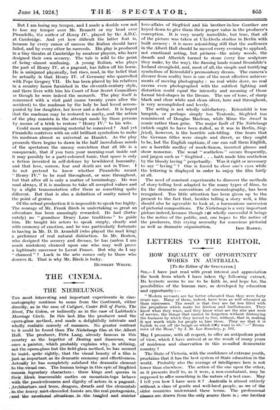THE CINEMA.
TUE NIEBELVNGS.
Tim avast interesting and important experiments in eine- matogsaphy continue to come from the Continent, either direegy, as in the. ease of Caligari, Coster Bill of Paris, The Street, The Golent, es indirectly- as in the case of Lubitsch's
Marriage GiwL In ,this last, the producer. used the opera-glass method, ,and, made a, delightfully intricate and wholly. _realistic comedy of mariners. No greater contrast to it could be found than The Niebelungs fiku.st the Albert Hall. The producer, Fritz Lang, already famous in this _country as the begetter of Destiny. and Sumurun, -was • once: a- painter,. which probably explains why, in utilizing, not the -opera"glass but the field-glass method, he has seemed :to. insist, quite rightly, -that the visual beauty. of _a film is just wimportant as its dramatic economy and effectiveness. Actually he has completely subdued the dramatic element the.visual one. The human beings in this epic vf Siegfried remain legendary characters : these kings .-and queens in , their bleak inaccessible castles on mountain-tops behave with, the passionlessness and dignity of actors in a pageant. Arehiteetnre, and treeSt ,dragrina, dwarfs and the elementals .40...the heavy, mist-shrouded .forests art the real protagonists, Likud the einotiunal .aituationa,in..the tangled and sinister love-affairs of Siegfried and his brother-in-law Gunther are keyed down to rgive them their proper value in the producer's conception. It is very nearly incredible, but true, that all of the picture was taken at Ufa-Decla studios in Berlin with built scenery : it is more astonishing still that the audiences in the Albert Hall should be moved every evening to applaud, not emotional acting, but pictures—the misty woods, the dwarfs and Alberich turned to stone (very fine sculpture they make, by the way), the flaming lands round Brunhilde's Iceland stronghold, and, most of all, the simple and terrifying symbolism of Kriernhild's premonitory dream. The camera's divorce from reality here is one of the most effective achieve- ments of moving photography : no real white dove, no real ravens even photographed with the subtlest lighting and distortion could equal the intensity and meaning of those formal bird-shapes in the Dream. The use of tone, of sharp black and clear white and clean silver, here and throughout, is very accomplished and loveLy.
The acting is not wholly satisfactory. Kriemhild is too lumpish, or perhaps simply too Teutonic, Siegfried too reminiscent of Douglas Maclean, while Mime the dwarf is comic rather than grim. The major fault of The Niebelungs (which ought to have been called, as it was in Berlin, Sieg- fried), however, is the horrible sub-titling. One hears that the German titles were simple and direct, as they ought to be, but the English captions, if one can call them English, are a horrible medley of mock-Saxon, inverted phrase and sheer nonsense. The word " ecatheless " . occurs frequently, and jargon such as " Siegfried . . . bath made him scatheless by the bloody laying" perpetually. Was it right or necessary to say " laving " ? One is forced to close one's eyes while the lettering is displayed in order to enjoy the film fairlY at all.
The need of constant experiments to discover the methods of story-telling best adapted to the many types of films, to Ax the dramatic conventions of cinematography, has been recognized. Too little attention has been given up to the present to the fact that, besides telling a story well, a film should also be agreeable to look at, a harmonious succession of pictorial compositions. The Niebelungs is a very important picture indeed, because though rot wholly successful it brings to the notice of the public, and, one hopes to the notice of the producers, this crying necessity for conscious pictorial










































 Previous page
Previous page